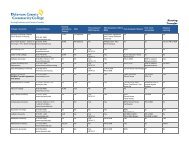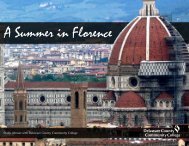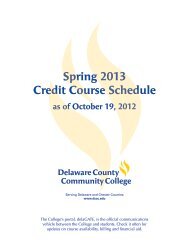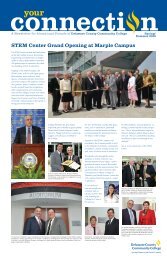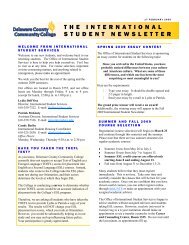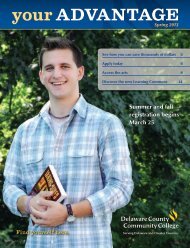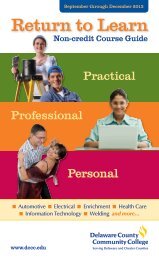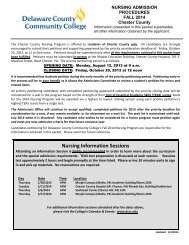2010 Catalog - Delaware County Community College
2010 Catalog - Delaware County Community College
2010 Catalog - Delaware County Community College
Create successful ePaper yourself
Turn your PDF publications into a flip-book with our unique Google optimized e-Paper software.
124 COURSE DESCRIPTIONS<br />
• Apply organizational theory to the practical performance<br />
of management functions.<br />
• Use internal operational controls.<br />
• Plan and design a menu.<br />
• Purchase, receive, store and issue food.<br />
• Design and lay out the operational areas.<br />
• Deliver prepared foods to consumers.<br />
• Perform administrative tasks with regard to personnel.<br />
• Promote and merchandise products and services of a<br />
food-service operation.<br />
Prereq. HRM 100<br />
3 Credits 3 Weekly Lecture Hours<br />
HRM 254<br />
Quantity Foods and Catering<br />
This course emphasizes the use of standardized recipes,<br />
work improvement techniques, menu pre-costing/pricing in<br />
the planning of quantity foodservice operations. Discussions<br />
include catering, on/off premise event planning, sales and<br />
marketing practices and operational reports/record keeping.<br />
Students will plan and serve a quantity food event.<br />
Upon successful completion of this course, the student<br />
should be able to:<br />
• Use formulas in determining food yields and perform<br />
recipe conversions for large groups.<br />
• Eliminate unnecessary work in a quantity food situation<br />
through the use of continuous process improvement.<br />
• Use banquet/catering management practices, policies and<br />
procedures as they relate to planning, organizing, staffing<br />
and controlling a large party/event.<br />
• Explore the current computer software designed for<br />
catering management.<br />
• Plan, serve, and cost a special event for a large party.<br />
Prereq. HRM 151<br />
3 Credits 3 Weekly Lecture Hours<br />
HRM 255<br />
Beverage Management<br />
This is a course for those wishing to learn how to operate<br />
a beverage outlet and serve controlled beverages responsibly.<br />
This is not a bartending course. The course includes restaurant<br />
bar operations, hotel room beverage service, catering<br />
bar systems and beer distributors. The federal standards of<br />
identity under USCA 27 and Pennsylvania Law Title 47<br />
and any appropriate criminal codes will be presented.<br />
Upon successful completion of this course, the student<br />
should be able to:<br />
• Make personal choices in career development and<br />
business decisions with regard to beverage management.<br />
• Structure task performance within a beverage operation.<br />
• Purchase, receive, store and issue beverages in<br />
accordance with generally accepted procedures.<br />
• Properly use equipment, tools and terminology specific<br />
to beverage operations. Demonstrate the basic practices<br />
of mixology.<br />
• Apply merchandising techniques within an overall<br />
marketing strategy of a beverage operation.<br />
• Gather and apply information for internal control and<br />
operational decision making.<br />
• Discuss third-party liability as affected by the<br />
environment of a beverage operation.<br />
• Apply federal, state and local regulations/laws specific to<br />
beverage commerce.<br />
Prereq. HRM 100<br />
3 Credits 3 Weekly Lecture Hours<br />
HUM 100<br />
(HUM) Humanities<br />
Introduction to Visual Arts<br />
This course is designed to introduce students, through a<br />
broad overview, to the nature of art, the people who make<br />
art, the various forms art takes and to the importance of<br />
art in our everyday lives. Students consider the role of the<br />
artist in society and how that role changes historically.<br />
Issues such as aesthetics, creativity and perception, and<br />
what it means to be a visually literate patron of the arts<br />
will be explored. A thorough introduction to the visual<br />
elements and principles of design will help students to<br />
form some guidelines for analysis and criticism in such<br />
areas as drawing, painting, photography, film, video,<br />
sculpture, architecture, crafts, environmental design,<br />
theater, dance and music.<br />
Upon successful completion of this course, students<br />
should be able to:<br />
• Identify several themes and purposes of art.<br />
• Identify the visual elements and apply them in analysis<br />
of various two-and three-dimensional media.<br />
• Identify the principles of design in art.<br />
• Apply principles of design and personal aesthetics to<br />
criticism and analysis of various art media.<br />
• Demonstrate an understanding of a comprehensive list of<br />
terms common in the art world and apply those terms in<br />
written criticism.<br />
• Demonstrate a knowledge of a variety of roles artists<br />
have assumed in society.<br />
• Demonstrate a knowledge of the traits characteristic of<br />
these artists and their styles.<br />
• Demonstrate a knowledge of tools, methods and<br />
materials used in a broad spectrum of two-and threedimensional<br />
media.<br />
• Demonstrate a sense of the chronological history of the arts.<br />
Prereq. ENG 100<br />
3 Credits 3 Weekly Lecture Hours<br />
HUM 106 Dante Alighieri's Inferno<br />
Special Studies<br />
This course introduces students to the first book of Dante<br />
Alighieri’s ‘Divina Commedia’, i.e. Inferno (Hell).<br />
Upon successful completion of this course, students<br />
should be able to:<br />
• Recognize concepts, beliefs and symbols and historical<br />
facts of Medieval Europe and medieval Christianity.<br />
• Understand how some popular Christian value became<br />
part of European and American culture.<br />
• Understand some aspects of Italian culture and the<br />
impact of poetry and literature on individuals and<br />
the world.<br />
• Contribution of Dante and the Florentine culture to the<br />
diversity of human culture (rewrite this one)<br />
3 Credits 3 Weekly Lecture Hours<br />
HUM 110<br />
Humanities and the Arts I<br />
Students survey the creative works of man through the<br />
ages: Greek-Roman Classical, Medieval, Renaissance, Baroque.<br />
Upon successful completion of this course, students<br />
should be able to:<br />
• Relate cultural patterns to major periods in the arts.<br />
• Explain the major reasons-historic, sociologic, economic,<br />
aesthetic-for the emergence of various cultural patterns.<br />
• Trace the flow of cultural patterns of the present from the<br />
past into the future.<br />
• Discuss the major aesthetic principles of poetry, prose,<br />
painting, music, architecture and sculpture.<br />
• Compare and/or contrast the characteristics of the major<br />
periods of the arts.<br />
• Find a richer life experience through a deeper<br />
involvement with the arts.<br />
Prereq. ENG 050 and REA 050<br />
3 Credits 3 Weekly Lecture Hours<br />
HUM 120<br />
Humanities and the Arts II<br />
Students survey some of the creative works of man through<br />
the ages: Romantic, Realistic, Impressionistic, Modern.<br />
Upon successful completion of this course, students<br />
should be able to:<br />
• Relate cultural patterns to major periods in the arts.<br />
• Explain the major reasons-historic, sociologic, economic,<br />
aesthetic-for the emergence of various cultural patterns.<br />
• Trace the flow of cultural patterns of the present from the<br />
past into the future.<br />
• Discuss the major aesthetic principles of poetry, prose,<br />
painting, music, architecture and sculpture.<br />
• Compare and/or contrast the characteristics of the major<br />
periods of the arts.<br />
• Find a richer life experience through a deeper<br />
involvement with the arts.<br />
Prereq. ENG 050 and REA 050<br />
3 Credits 3 Weekly Lecture Hours<br />
HUM 141<br />
Film Language<br />
This course is intended to engage students in analysis of<br />
the film medium, to help them relate the art of film to their<br />
lives and their language and to stimulate their appreciation<br />
of the visible world. The course includes a brief survey of<br />
film history, a study of the subject matter and bias of the<br />
documentary film and visible forms of poetry in the art film.<br />
Upon successful completion of this course, students<br />
should be able to:<br />
• Identify types of films.<br />
• Recognize stages in film history.<br />
• Identify elements of cinematic technique.<br />
• Discuss the aesthetics of film.<br />
• Recognize the existence of varying critical approaches.<br />
• Recognize a good film.<br />
Prereq. ENG 100<br />
3 Credits 3 Weekly Lecture Hours<br />
HUM 142<br />
American Cinema<br />
This introductory course in film studies surveys American<br />
motion pictures as an industry, a form of artistic<br />
expression and a powerful cultural and societal influence.<br />
Students taking this course as distance learning should be<br />
aware of its independent study aspects.<br />
Upon successful completion of this course, students<br />
should be able to:<br />
• Demonstrate a familiarity with American film history from<br />
the silent screen to the present.<br />
• Demonstrate a knowledge of the basic technical and<br />
critical vocabulary of motion pictures.<br />
• Apply that vocabulary to understand artistic expression in<br />
motion pictures.<br />
• Demonstrate an understanding of the fundamentals of<br />
the movie industry's economic structure as it evolved<br />
through the twentieth century.<br />
• Demonstrate an informed view of "realism" in motion<br />
pictures in order to avoid passive acceptance of what is<br />
presented on the screen.<br />
Prereq. ENG 100<br />
3 Credits 3 Weekly Lecture Hours<br />
HUM 160<br />
Introduction to World<br />
Religions<br />
This course introduces students to the five major<br />
religions of the world: Hinduism, Buddhism, Judaism,<br />
Christianity and Islam.<br />
Upon successful completion of this course, students will<br />
be able to:<br />
• Explain the developmental stages of each of the five<br />
major religions.<br />
• Evaluate the principal tenets of each of these belief systems.<br />
• Describe the most important rituals of each of<br />
these religions.<br />
• Analyze the relationships that exist among these religions<br />
3 Credits 3 Weekly Lecture Hours<br />
DELAWARE COUNTY COMMUNITY COLLEGE




